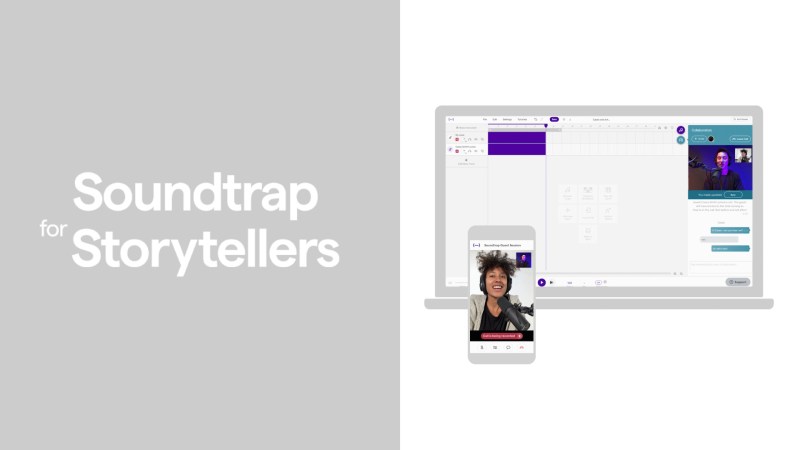It’s been a little over a year since Spotify snatched up Stockholm-based Soundtrap, a relatively small company of around 35 employees creating a suite of music and podcast recording tools. The terms of the deal weren’t disclosed at the time, save that the entire team would join Spotify, including founders Björn Melinder, Fredrik Posse, Gabriel Sjöberg, and Per Emanuelsson. And although they remain as much a mystery now as then, the Soundtrap team today revealed what it’s been developing post-acquisition.
Soundtrap’s newest creation is Soundtrap for Storytellers, a cloud-based app for podcast production that’s available this week starting at $14.99 per month or $143.88 per year ($11.99 per month billed annually). According to Charlie Hellman, head of Spotify’s creator marketplace, it’s designed to streamline the publishing process with a user-friendly, collaborative toolset that’s both powerful and efficient.
“The Soundtrap team has done a fantastic job with this new product. Part of Spotify’s mission is to grow the number of creators able to build podcasts worldwide,” he said. “Soundtrap for Storytellers gives podcast creators incredible editing capabilities, collaboration in real time, and the ability to publish their podcast to Spotify.”
Toward that end, Soundtrap for Storytellers — which is accessible via desktop, with a select set of recording and editing features available on iOS and Android — offers an editing studio from which podcasters can transcribe and edit spoken-word audio files (in English at launch). A remote interview component enables creators to invite multiple guests to talk, record (on separate tracks), and work on the same podcast by joining a session from a unique URL. Meanwhile, a library of sound effects, instruments, and loops lets authors create their own intro and outro music, and a discoverability tool optimizes podcast transcripts for SEO.
June 5th: The AI Audit in NYC
Join us next week in NYC to engage with top executive leaders, delving into strategies for auditing AI models to ensure fairness, optimal performance, and ethical compliance across diverse organizations. Secure your attendance for this exclusive invite-only event.

In many ways, Soundtrap for Storytellers is an evolution of Soundtrap’s existing free and paid service, which lets users record, edit, and publish audio solo or with others across iOS, Android, Chromebook, Linux, Mac, and Windows. Whereas it was largely general-purpose, Emanuelsson says that Soundtrap for Storytellers was built from the ground up to address podcast creators’ pain points.
“Soundtrap was created to redefine … music making, and now we’re bringing that same expertise to podcast creation with Soundtrap for Storytellers,” he said. “The platform itself was built around solving some of the biggest pain points for podcasters — editing, transcribing, remote interviewing and adding sound effects — and providing one streamlined platform that contains every part of the podcast creation process.”
It’s a mission that jibes with Spotify’s own, particularly as music streaming service — which in April reported that it had 100 million paying monthly active users (MAUs) and 217 MAUs overall — makes podcasts a core part of its original content strategy. It recently purchased podcast networks Gimlet and Anchor for €308 million ($344 million), and in April, Spotify bought story-based podcasting studio Parcast for €50 million ($56 million).
In its 2018 Q4 shareholder letter, Spotify said it had earmarked up to $500 million for similar deals throughout this year. “Based on radio industry data, we believe it is a safe assumption that, over time, more than 20 percent of all Spotify listening will be non-music content,” said Spotify CEO Daniel Ek in early 2019.
It’s a sound strategy, given that podcast production and listenership have seen a huge uptick over the past few years. Apple in 2018 said that there were over 525,000 active shows and over 18.5 million episodes on iTunes, and according to a study conducted last year by research firm Infinite Dial, more than 44% of the U.S. population — 124 million people — have listened to at least one podcast, up from 40% in 2017. Moreover, an Edison Research report into podcast listening trends found that 26% of people in the U.S. consumed at least a podcast each month in 2018, an increase of two percentage points on the previous year.
The trend has been a boon for advertisers, unsurprisingly. Recent data from the Internet Advertising Bureau (IAB) suggests that digital audio ad revenues rose 42% to $603 million in the first half of 2017 and hit $1.6 billion by the year’s end.
Indeed, Spotify expects podcasts to become a lucrative part of its ever-growing audio library. “We expect the revenue from podcasts to accelerate through 2019,” Spotify told investors in February. “Over time, our ambition is to develop a more robust advertising solution for podcasts that will allow us to layer in the kind of targeting, measurement, and reporting capabilities we have for the core ad-supported business.”
